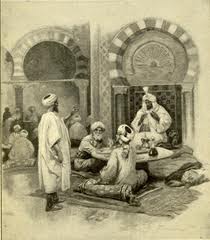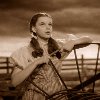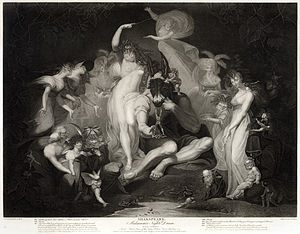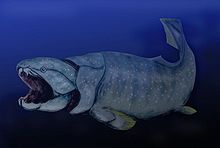 “Once a Caliph saw his teeth falling out in a dream. He called a dream interpreter and asked him about the meaning of his dream. The interpreter replied: ‘The entire family of my master will perish.’ The Caliph became upset, and called for another interpreter and told him the dream. The second dream interpreter replied: ‘The dream of my master, the prince of believers, is true, for he shall live the longest amongst his relatives.’ Immediately the Caliph embraced the man and rewarded him for his skill and tactfulness.” (quoted in Amira Mittermaier, “Dreams That Matter: Egyptian Landscapes of the Imagination,” p. 63)
“Once a Caliph saw his teeth falling out in a dream. He called a dream interpreter and asked him about the meaning of his dream. The interpreter replied: ‘The entire family of my master will perish.’ The Caliph became upset, and called for another interpreter and told him the dream. The second dream interpreter replied: ‘The dream of my master, the prince of believers, is true, for he shall live the longest amongst his relatives.’ Immediately the Caliph embraced the man and rewarded him for his skill and tactfulness.” (quoted in Amira Mittermaier, “Dreams That Matter: Egyptian Landscapes of the Imagination,” p. 63)
More Black & White vs. Color in Dreams
 Mary Walsh, a psychotherapist and grad student at the GTU, offered an intriguing idea about color variations in dreams: “I wonder if the change in our waking experience of color impacts our dream experience. Photopic vision functions only in good illumination which we have more of for longer periods of time nowadays. Scotopic, or night vision, I think, provides the ability to distinguish between black and white. Could the fact that we see more color for more hours each day and use our photopic vision more cause us to dream in color more often? Maybe dreams have changed.”
Mary Walsh, a psychotherapist and grad student at the GTU, offered an intriguing idea about color variations in dreams: “I wonder if the change in our waking experience of color impacts our dream experience. Photopic vision functions only in good illumination which we have more of for longer periods of time nowadays. Scotopic, or night vision, I think, provides the ability to distinguish between black and white. Could the fact that we see more color for more hours each day and use our photopic vision more cause us to dream in color more often? Maybe dreams have changed.”
I think Mary’s right that more attention to the neurophysiology of vision and the cultural/technological changes of modernity will be helpful in making better sense of this question.
Also, Bob Van de Castle reminded me that his 1994 book Our Dreaming Mind has a good discussion of color dreams (pp. 253-256 and 298). After reviewing several experimental studies, Van de Castle concludes that “color appears in dreams with much greater frequency than is generally acknowledged. The saturation or intensity of color in dreams seems to vary along a continuum.” (p. 255)
Bob Hoss is another IASD member who has done especially detailed investigations of color in dreams.
I’ve just read Eric Schwitzgebel’s longer paper, “Why did we think we dreamed in black and white?” in 2002, and I’m grateful for his extensive research on this topic. He admits that he has larger philosophical fish to fry–he says “I write in service of the broader thesis that people generally have only poor knowledge of their own conscious lives, contrary to what many philosophers have supposed.” (p. 649), an argument he elaborates in his recent book Perplexities of Consciousness (2011). I don’t think I’d want to argue with him about that general idea. And I agree that “our knowledge of the phenomenology of dreaming is much shakier than we ordinarily take it to be” (p. 649).
But I suspect Schwitzgebel views this as an insoluble problem because of the fundamental limits of introspection and conscious self-knowledge. I see it as a problem that can be solved by better empirical research that builds our knowledge of dream phenomenology on firmer foundations.
Looking at some of the initial data I’ve drawn from the SDDb, it seems clear that most people dream fairly often, but by no means always, of colors and black and white.
Here’s a link to an SDDb search for reports of 25+ words with references to achromatic colors. 472 reports show up, out of 5193 reports of that length. White appears most often, black next, gray third.
And here’s a link to an SDDb search for reports of 25+ words with references to chromatic colors. 476 reports show up, out of 5193 reports of that length. Red appears most often, followed by blue, green, yellow, orange, and purple.
In studies of people who have kept long-term dream journals, I’ve found lots of variation in this area. Some people have more chromatic color references in their dreams, and other people have more achromatic references. Some people have very high overall frequencies (e.g., Merri, whose dream series of 315 dreams is available on the Dreambank, has by my count 44.4% of her dreams with at least one chromatic reference and 40% with at least one achromatic reference) and others quite low (Paul, whose series of 136 dreams is available on the SDDb, has 0% chromatic and 1.47% achromatic references).
I don’t know of any theoretical perspective that can encompass all this data. Isn’t it paradoxical to think about the colors we see when we’re asleep and our eyes are closed? Perhaps we need a new paradigm entirely to make adequate sense of the visual qualities of dreaming experience.
But I still hold to my “Dorothy Hypothesis”: This whole question in mid-20th century psychology of whether we dream in color or black & white was generated by the 1939 release of The Wizard of Oz, with its dramatic contrast between the drab black & white (sepia, really) of Kansas and the gaudy, transcendent technicolor of Oz.
Note: Schwitzgebel’s article appeared in Studies in History and Philosophy of Science 33 (2002), 649-660.
Dreaming in Black and White
 The Wizard of Oz was originally released in 1939, viewed by millions of Americans who delighted in its novel cinematic analogy that waking is to dreaming as black & white film is to color film. I’ve always assumed the question “Do we dream in color or black & white?” originated with the huge cultural impact of The Wizard of Oz. I’ve study many dream traditions around the world, and while some typical dream phenomena are cross-cultural (e.g., flying, snakes, teeth falling out), the color vs. black & white question does not seem to be one of them. Perhaps such a question can only arise in a culture in which people are viewing both color and black & white photos, films, and television shows.
The Wizard of Oz was originally released in 1939, viewed by millions of Americans who delighted in its novel cinematic analogy that waking is to dreaming as black & white film is to color film. I’ve always assumed the question “Do we dream in color or black & white?” originated with the huge cultural impact of The Wizard of Oz. I’ve study many dream traditions around the world, and while some typical dream phenomena are cross-cultural (e.g., flying, snakes, teeth falling out), the color vs. black & white question does not seem to be one of them. Perhaps such a question can only arise in a culture in which people are viewing both color and black & white photos, films, and television shows.
Recently I found an article I wish I had known earlier, by Eric Schwitzgebel: “Do People Still Report Dreaming in Black and White? An Attempt to Replicate a Questionnaire from 1942.” Schwitzgebel says, “In the 1940’s and 1950’s, dream researchers commonly thought that dreams were primarily a black & white phenomenon…However, by the 1960’s, most researchers reported a high incidence of color in dreams” (p. 25). To investigate this strange psycho-cultural shift, Schwitzgebel replicated a 1942 study by W. C. Middleton in which college students were asked about their dream recall and colors in their dreams. His results from a 2001 sample of students found a big difference: “The undergraduates in the present study reported much more colored dreaming than Middleton’s undergraduates in 1942.” (p. 28)
The exact question was, “Do you see colors in your dreams?” “Very frequently” was the answer of 3.3% of the 1942 students (N=277) and 26.6% of the 2001 students (N=124); “Frequently,” 7.0% vs. 25.8%; “Occasionally,” 19.0% vs. 22.6%; “Rarely,” 30.8% vs. 13.3%; and “Never,” 39.9% vs. 4.4%.
Schwitzgebel ends his paper by saying, “If it is plausible to suppose that dreams themselves have not changed from black and white to color in this interval, we may conclude that one or another (or both) groups of respondents were profoundly mistaken about a basic feature of their dream experiences” (p. 29).
This seems too harsh to me. As I mentioned at the outset, this color vs. black & white question is not a natural one. The participants in Middleton’s 1942 study would have been high school students when The Wizard of Oz came out three years earlier. I wonder if they interpreted the survey question as meaning, do you ever dream like Dorothy did in the movie, in fantastically vibrant technicolor? In the cultural shadows of World War II and the Great Depression, it may not be surprising that most of the students answered “no.”
Another finding in Schwitzgebel’s study, which he doesn’t discuss, is that dream recall in general seems to have risen. The participants in both studies were asked “How frequently do you dream?” “Very frequently” was the answer of 13.4% of the 1942 students and 27.4% of the 2001 students; “Frequently,” 24.9% vs. 33.9%; “Occasionally,” 41.5% vs. 25.0%; “Rarely,” 30.8% vs. 13.3%; “Never,” 0.3% vs. 0.4%. Based on these findings, it seems that not just color in dreams but dream awareness overall is greater now than in 1942.
However, Schwitzgebel’s study was performed in 2001, with students who passed their formative years in a decade of relative peace and prosperity. Would we find the same results today if we replicated the questionnaire a third time, with students in 2012 who grew up in the cultural shadows of the War on Terror and the Great Recession?
Note: Schwitzgebel’s article appeared in Perceptual and Motor Skills, 2003, vol. 96, pp. 25-29.
Oregonian Commentary on the Politics of Dreaming
 In today’s Oregonian newspaper I published a commentary piece titled “The politics of dreaming: Even in sleep, Americans show a partisan divide” (4/30/12, p. A9). It’s the latest version of my ongoing study of the interplay of sleep, dreams, and political ideology.
In today’s Oregonian newspaper I published a commentary piece titled “The politics of dreaming: Even in sleep, Americans show a partisan divide” (4/30/12, p. A9). It’s the latest version of my ongoing study of the interplay of sleep, dreams, and political ideology.
Shakespeare Dream Quotes
 In honor of the April 26, 1564 baptism of William Shakespeare and his death on April 23, 1616, I have gathered a few of the best quotes about dreams from characters in his plays. Let me know if you’ve got other good ones!
In honor of the April 26, 1564 baptism of William Shakespeare and his death on April 23, 1616, I have gathered a few of the best quotes about dreams from characters in his plays. Let me know if you’ve got other good ones!
Prospero: “We are such stuff as dreams are made on, and our little life is rounded with a sleep.”
The Tempest, IV.i.156-158
“All days are nights to see till I see thee/And nights bright days when dreams do show me thee.”
Sonnet 43, 13-14
Gloucester: “My troublous dreams this night doth make me sad.”
Duchess: “What dreamed my lord? Tell me, and I’ll requite it with sweet rehearsal of my morning’s dream.”
Henry VI, Part II, I.ii.22-24
Romeo: “I dreamt a dream tonight.”
Mercutio: “And so did I.”
Romeo: “Well, what was yours?”
Mercutio: “That dreamers often lie.”
Romeo: “In bed asleep, while they do dream things true.”
Mercutio: “Oh, then I see Queen Mab hath been with you. She is the fairies’ midwife…”
Romeo and Juliet, I.iv.52-58
Horatio: “O day and night, but this is wondrous strange!”
Hamlet: “And therefore as a stranger give it welcome. There are more things in heaven and earth, Horatio, than are dreamt of in your philosophy.”
Hamlet, I.v.164-167
Hamlet: “To die, to sleep–No more–and by a sleep to say we end the heartache, and the thousand natural shocks that flesh is heir to. ‘Tis a consummation devoutly to be wished. To die, to sleep–To sleep–perchance to dream: ay, there’s the rub, for in that sleep of death what dreams may come when we have shuffled off this mortal coil, must give us pause.”
Hamlet, III.i.60-68
Puck: “If we shadows have offended, think but this and all is mended, that you have but slumber’d here, while these visions did appear. And this weak and idle theme, no more yielding but a dream.”
Midsummer Night’s Dream, V.i.425-430
Here’s a link to the search page for the OpenSource Shakespeare website, where you can type in “dream” and find all references to dreaming in Shakespeare’s works.
Animals in Dreams
 Below is the section on animal dreams from my video talk for the IASD Australian Regional Conference held last week in Sydney. I would be very interested in hearing from people whose dreams include types of animals NOT mentioned in my findings, to help us develop an even broader sense of oneiro-zoology (yes that’s a made up word!).
Below is the section on animal dreams from my video talk for the IASD Australian Regional Conference held last week in Sydney. I would be very interested in hearing from people whose dreams include types of animals NOT mentioned in my findings, to help us develop an even broader sense of oneiro-zoology (yes that’s a made up word!).
Animals: I searched the SDDb for many different types of animal-related words, but I’m sure I missed some, so this is an area needing improvement. What I found in this study [of 2087 total dreams, 1232 female and 855 male] was 16% of the female reports and 14% of the male reports including at least one animal reference. Consistent with what previous researchers have found, the children’s dreams in my sample have a higher percentage of animal references (24% for the girls, 20% for the boys). Does this mean children are “closer” to nature than adults? Perhaps. It does seem that a higher proportion of animals in children’s dreams (or should we say a diminished proportion of animals in modern Western adults’ dreams?) is a stable pattern across many studies.
The animals that appeared most often were, in order, dogs, cats, horses, bears, fish, snakes, birds, and insects. The first three—dogs, cats, and horses—are among the most familiar domestic animals. Bears are NOT domestic animals, and they actually appear most often to be aggressive, threatening creatures in dreams. Among different types of fish, sharks appear frequently like bears, as frightening predators, putting the dreamer in the harrowing position of prey, the hunted. In other dreams, however, ocean dwelling creatures like whales and dolphins reveal an amazing intelligence that teaches the dreamer something new about the natural world.

